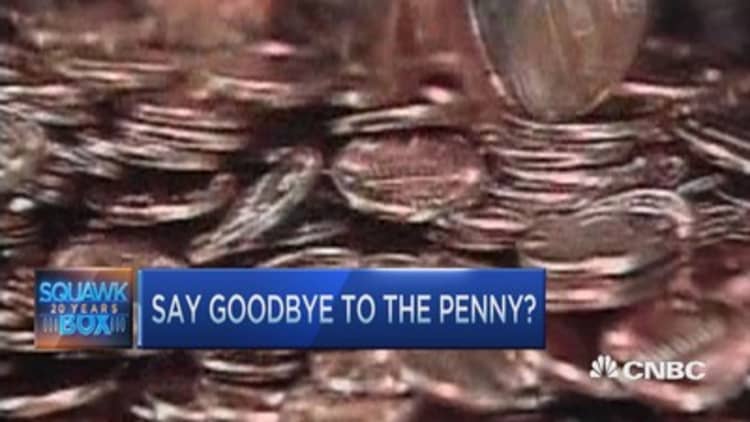
Former U.S. Mint Director Philip Diehl has advice for anyone who has ever come across a penny and thought about bending over to pick it up.
Don't. You'll be earning less than the minimum wage for your troubles.
Diehl, now the president of coin distributor U.S. Money Reserve, is one voice in a chorus that wants to abolish the penny. In fact, he tried to do just that during his time as the 35th director of the U.S. Mint.
At issue is the fact that the penny now costs more to make than it's worth. The U.S. Mint loses tens of millions of dollars each year producing pennies, which cost 1.8 cents to produce.
But some say eliminating the penny will distort prices and perhaps even create mild inflation. Diehl, however, says there is not much to that assertion.
"I think it's an argument that has been used for the last 25 years by the penny lobby that supports keeping the penny," he said. "The reality is that about 25 percent of all transactions are now in cash. The other 75 is in electronic forms of one type or another."
What's more, only a small percentage of transactions would be affected if the penny were discontinued, Diehl said. Companies would likely round down prices rather than upset customers with price increases to account for the inability to price in 1-cent increments, he said.
"Why would you irritate a customer over a penny?" he asked.
Among the coin's protectors are the private interests that make penny blanks, the discs the U.S. Mint later stamps and bags, and the zinc lobby, Diehl said, noting the penny is 97.5 percent zinc.
Americans for Common Cents, a group that backs the penny, claims the government would incur costs if it eliminated the penny and asserts charities would be hurt due to a reduction in pocket change contributions. The organization also says consumers will be hit with a "rounding tax" as retailers raise prices.
Mark Weller, the executive director of Americans for Common Cents, told CNBC there is no evidence to support the claim businesses would round down, noting that grocery and convenience stores operate on thin margins and the difference of a few cents matters to them.
He is also a partner at Dentons, a law firm that represents Jarden Zinc Productions, which makes penny blanks.
Weller said the United States has fallen behind other countries, including Canada, in developing solutions to make its coins more economic. He said the mint had "punted" after Congress asked for suggestions to produce all coins at a lower cost in 2010.
"Here we are. It's the end of 2015, five years after Congress asked the mint to look at this and we're no closer than we were before," he said.
The Coin Modernization, Oversight, and Continuity Act of 2010 requires the secretary of the Treasury to provide a biennial report to Congress on coin production costs and alternatives.
Weller said it was shortsighted to focus on the penny, when the nickel costs 9.4 cents to make.
Diehl said all hope is not lost for the nickel, which is composed of a copper-nickel mix.
"We have a better opportunity to change the composition of the nickel and make it profitable or close to profitable. The penny is beyond hope," he said.


